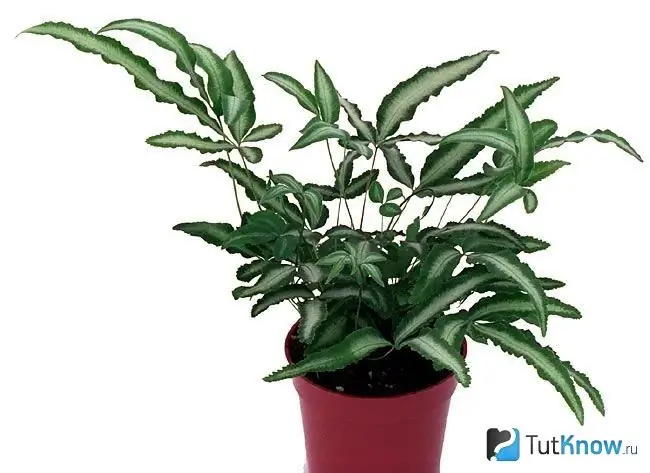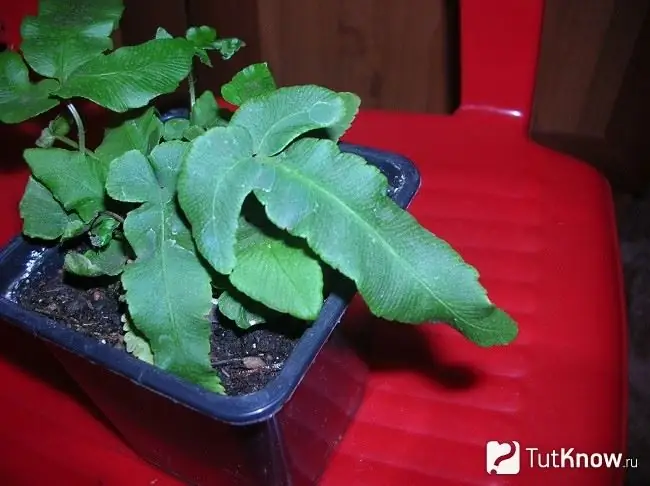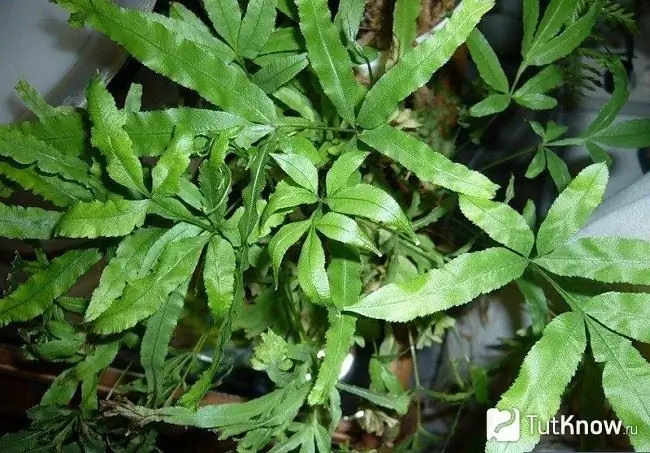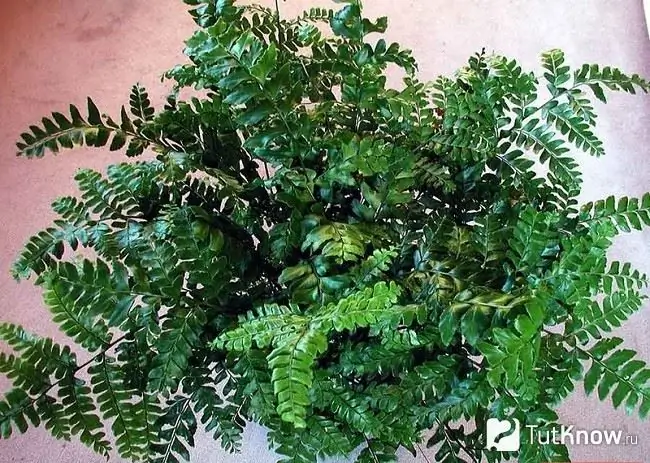- Author Arianna Cook [email protected].
- Public 2024-01-12 17:55.
- Last modified 2025-06-01 07:38.
The appearance of the pteris, recommendations for watering, soil selection, fertilization and transplantation, independent reproduction of bracken and its types. Pteris (Pteris) is part of the Pteris family (Pteridaceae), which has about 280 species of fern plants. The homeland of growth in natural conditions is the Japanese, American, South African, Mediterranean territories, the islands of New Zealand, where a tropical, subtropical climate predominantly prevails, but can be found in temperate climatic areas. An interesting fact is that in some areas of growth, the plant is considered a weed, which is rather difficult to eradicate and fight with bracken in all sorts of ways. This fern can choose dry coniferous and deciduous forests, thickets of bushes, where it reproduces in huge thickets for the growth site.
The name of the plant comes from the Greek word "pteron" - a wing, since the pteris (vai - long leaf plates) resemble the wingspan of the bird of the same name. The "bracken" is also considered a synonym for its name. This is due to the fact that the bundles of vessels with which the rhizome of the fern is dotted are very similar in section to the symbol of the eagle on the coats of arms of some countries. And then the origin of the name of this plant in French fougère imperiale or in the Polish interpretation of Orlica pospolita becomes clear. And also to some, these bundle vessels in the section resemble the initials of Jesus Christ - IC, therefore there are references to pteris as the Jesus grass.
Bracken is a plant that develops for many seasons and has a herbal form of growth. Pteris is not an epiphyte (it does not grow on other trees), it is located only on the soil surface. The span of its "winged" leaves can reach from 60 cm to 2.5 m in height and length. The bracken's rhizome is small in size and is completely covered by a layer of hairs and scaly formations. The plant has a medium to high growth rate.
Leaves attract attention with their leathery appearance and increased elasticity. They can be naked or covered with hairs. Some varieties have variegated colors. On the edge of the leaf lobes, sporangia (rows of spores that the plant reproduces with) are located. The color of the leaf plates is rich emerald. However, not all leaves have spores. Those leaf blades that are spore (fertile) look more decorative and have some elongation. Sterile (no spores) - are located on a shorter petiole and have a wider shape.
The plant is very beloved by many designers, as, because of its decorative wai, it makes it possible to decorate rooms and grow in greenhouses or conservatories. If you need to decorate a room with a large area, then this plant is just right, since its leaves have a beautiful spreading appearance. Pteris is completely unpretentious and even inexperienced growers can be engaged in its cultivation. The plant is so adaptable to life that it can feel normal in the shade and under artificial lighting, so it can be grown in a bathroom.
The most interesting thing is that the plant is actively used in countries such as China, Japan, Korea and even in some regions of Russia for food. Young shoots and leaf plates are used. A special starch is produced from luxurious bracken leaves and pies are made with it in Japan. And since the pteris rhizome contains about 46% starch, it is used in the manufacture of glue and beer drinks. The ash that remains from the burning of bracken contains a large amount of potash and on the basis of it a variety of detergents and refractory glass are produced.
Due to its medicinal properties, pteris is also used for medicinal purposes. A decoction is prepared from the leaves, which is prescribed for bleeding, chest pain, manifestations of dysentery infections and diseases of the genitourinary system. Worms are chased away with bracken juice and dysentery is also treated.
Attention! In many countries (Canada, USA, India, England and many other, North American, European and Asian countries), the plant is mentioned as a representative of the flora with high toxicity. Since they like to feast on cloven-hoofed animals (horses), cattle and poisoning of pigs were possible. This must be taken into account when placing pteris in a home where there are pets.
Recommendations for growing pteris indoors

- Lighting. This unpretentious inhabitant of tropical areas can thrive both in sufficient lighting and in completely shaded. Therefore, the bracken pot can be installed in the depths of rooms, and even in rooms that do not have windows. If the pteris is planned to be placed on the windowsill, then windows of any orientation, except for the southern one, will do. From bright lighting and direct rays of the sun, the plant must be shaded. For this, paper, curtains made of lightweight fabrics or gauze are used. With the arrival of stable warm temperatures, the bracken should be taken out into the air - this can be a balcony, terrace or garden. But it is necessary to choose a place in which the pteris will be reliably protected from precipitation, drafts and the influence of sunlight. If this cannot be done, then the plant is very fond of frequent ventilation of the room. With the arrival of the winter months, it is necessary to move the pteris pot closer to the windows or use special phytolamps or fluorescent lamps, which must be installed above the plant at a height of up to half a meter. Artificial lighting should be at least 8 hours. And even with the arrival of cold weather, the air in the room in which the bracken is located requires frequent ventilation.
- Air humidity. Pteris loves high levels of humidity and therefore can be installed even in bathrooms. It is necessary to spray this plant often enough. With dry indoor air, this operation is carried out at least once a day, sometimes more often. The spray water is softened, you can filter the water from the tap or pass it through a filter. Boiling is also allowed. The temperature should be room temperature (about 20-23 degrees). Perhaps in order for the bracken to feel good, put the pot with the plant on moistened expanded clay or pebbles, which are poured into deep trays. The main thing is that the bottom of the flowerpot does not come into contact with the water poured into the pan. You can also use sphagnum moss, which is moistened with water and used to increase moisture. The plant can be equipped with shower procedures that will help remove accumulated dust from the leaves, additionally moisturize them. It is only necessary to cover the ground in the pot with a plastic bag so that tap water is not poured inside. It is not recommended to wipe the leaves with various means to give them shine.
- Bracken content temperature. Although the plant is native to tropical areas, pteris thrives best at moderate heat levels. The temperature at normal humidity should be maintained around 20-23 degrees. If it begins to rise, over 24, then the plant should be often sprayed and a humidifier or vessels with water should be installed next to it. Since dry air, coupled with high temperatures, is very harmful to the fern. With the onset of autumn and up to the spring months, heat indicators can be lowered to 14-17 degrees, but care must be taken that they do not fall below 12, if the pteris species has leaf plates of a uniform green color. With a variegated color of the leaves, the thermometer should not fall below 15 degrees. During this period, the pot must be placed away from central heating batteries and all kinds of heaters.
- Watering the pteris. When the period of bracken growth begins, and it falls on the spring-summer months, then watering should be moderate and the soil is moistened only when its top layer in the flowerpot is dry. With the arrival of autumn, watering decreases. Drying of the soil serves as a signal for watering during this period, but moistening is performed only after 2-3 days. It is important to use water for irrigation that has settled well, and there are no lime and chloride impurities, various salts in it. It is recommended to take rainwater or melted snow, but its temperature should be room temperature. It is important that the substrate in the pot is always slightly moist, as overdrying and waterlogging have a detrimental effect on the pteris.
- Fern feeding. In order to maintain the normal growth and appearance of pteris, it is necessary to choose fertilizers that are intended for decorative deciduous plants growing in indoor conditions. The time for top dressing starts from late spring to the end of summer days. The dosage is halved than recommended by the manufacturer. With the arrival of autumn and in winter, the plant rests from fertilizing. Fertilizers are also used, which include organic matter.
- Soil selection and replanting recommendations. For this, the spring months are selected. The plant requires transplanting when the pteris root system has completely filled the pot. The pot is selected 3-4 cm larger than the previous one, wide, but not very deep. At the bottom, holes are drilled for the drain of excess water, a drainage layer of porous materials (small expanded clay or pebbles) is poured inside, no more than 1/4 of the total volume of the container. When transplanting, all damaged leaves (dried, broken or brownish) must be cut off as close to the rhizome as possible.
The soil for transplanting is taken with neutral acidity or slightly acidic reaction. The substrate should be lightweight and permeable to air and water. You can use purchased soils with the designation "for ferns". A soil mixture, which is compiled independently, is usually based on the following components: light turf soil, leafy soil, peat soil, humus, coarse sand (all parts must be equal).
Also, for young plants (seedlings) of bracken, you can use a mixture of peat, humus earth, leafy earth and river sand in proportions (2: 1: 2: 1). When the pteris has grown enough, the composition of the substrate can be added to the sod, and then the proportion already looks like this (3: 1: 3: 1: 2).
Indoor pteris breeding tips

This type of fern can be propagated both by spores and by dividing the bush.
Disputes can dissipate on their own. After ripening, the spores fall off the leaves and begin to germinate in the pot soil of the mother plant. After some time, young growth can be seen under the leaves of the pteris. These plants are dug up and transplanted into small-diameter pots (no more than 7 cm).
In order to breed bracken, it is necessary to collect spores. They look like brown bumps on the back of the leaves. They can be shaken off onto paper or scraped off with a sharpened knife. This operation should take place in early spring at a temperature of 13 degrees. To plant spores, you need to take a transparent container into which peat soil is poured and sprinkle it a little with water. After that, the collected spores are sown onto the surface. Containers with crops are placed in a shaded place and are waiting for the appearance of new plants. After the young seedlings appear, it is recommended to transplant them into separate pots.
Also, when a planned pteris transplant is carried out, you can carefully divide the overgrown bush. Since there are not many growth points in the fern and they are practically underground, division too often cannot be done. When dividing, special care is required, since you can accidentally separate a part of a bush in which there is no growth point. After the bush is divided, the parts of the pteris are planted in prepared pots with drainage and soil that is suitable for the growth of adult specimens.
Possible problems when growing bracken

Among the possible difficulties in the cultivation of pteris in indoor conditions, there are:
- An elevated indoor temperature is characterized by a change in the color of the leaves to yellow and the appearance of a brown spot. If the heat readings are kept around 25 degrees, this is detrimental to the fern. To maintain the plant, the humidity must be increased.
- The same symptoms correspond to the problem of poorly regulated watering and its inadequacy, as well as the reaction of leaf plates to direct sunlight, which caused burns.
- If the air humidity is not high and the pteris pot is located next to the heating devices, then this slows down the growth of the fern and leads to yellowing of the wai.
- If the illumination is very strong, then the leaf plates may become sluggish, differ in fading and translucency.
- The reason for the yellowing of wai, their deformation, the acquisition of a brown tint, discharge, as well as wilting and dying off of young leaves can be a decrease in the temperature in the room, the effect of a cold draft, moistening with water not at room temperature, but lower, and its high hardness and chlorination.
The plant can be attacked by scale insects or thrips, which manifest themselves as sticky, like a sugar bloom on the leaves. Pteris can be sprayed with soap or oil solutions. But if this method does not help, then insecticides are used.
Pteris species

There are many types of this fern, but you can dwell on the most popular ones:
- Pteris longifolia (Pteris longifolia). The main growing areas of the country are the Western Hemisphere with a subtropical and tropical climate. The leaves are pinnate and measure from 30 to 70 cm in length and 10-25 cm in width. There can be up to 30 pairs of individual leaves on the petiole. Their arrangement is uniform and they have an elongated-elongated linear appearance and a solid edge. There is a slight sharpening at the top. The surface of the leaves is glabrous, smooth. The petiole itself is measured in a length of about 20 cm, with a yellow-green tint, all covered with short scales. The species is loved by flower growers for its increased decorative effect.
- Pteris Cretan (Pteris cretica). Likes to settle on dry, hilly slopes in subtropical and temperate climates. Leaves reach 30 cm in length and 10-20 cm in width. They have a pinnately dissected shape. Leaves grow in pairs up to 12 units. They are distinguished by a hard surface, naked light green color. The leaves are linearly elongated (oblong), and those that are below are dissected into lobes. Spore-bearing leaves are longer and narrower than sterile ones. The edge of the leaves is serrated. The petiole has a slight backward curvature and is 20-30 cm long, pale brown in color.
- Pteris dentata (Pteris dentata) or fan-shaped (Pteris flabnellata) - differs in pinnate folded sheet plates, with an edge having small teeth.
- Pteris xiphoid (Pteris ensiformis) - spore-bearing fronds in the upper part have feathering in the form of 2-4 pairs of narrow linear leaves. The sterile ones slope downward and are formed in the form of a short triangle or egg.
For more on growing pteris at home, see this video:






